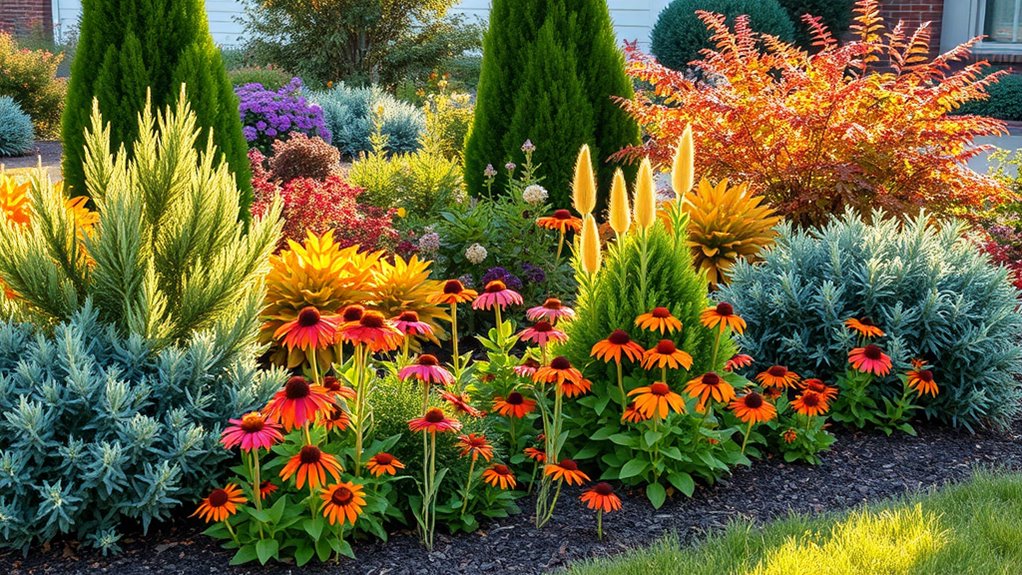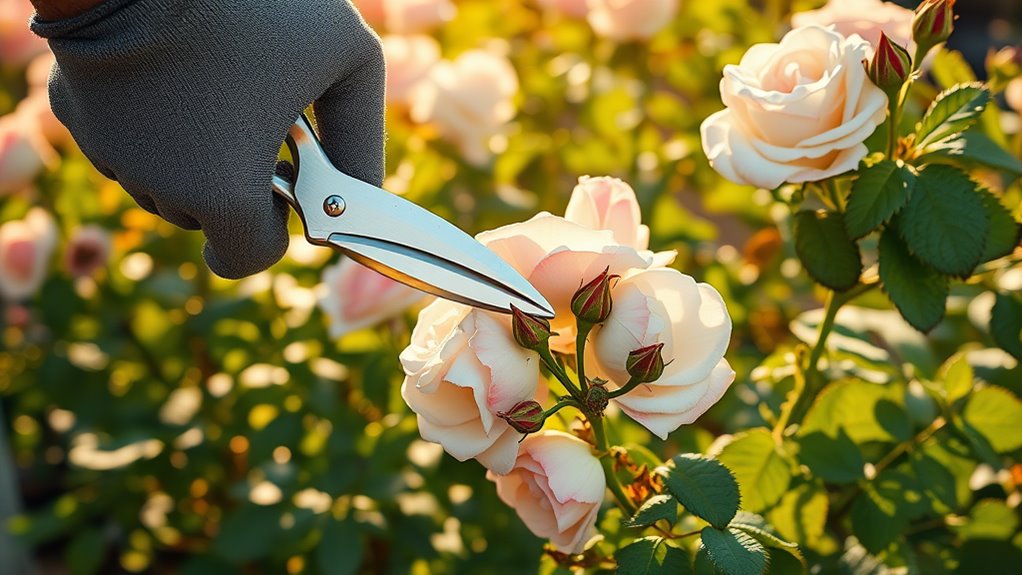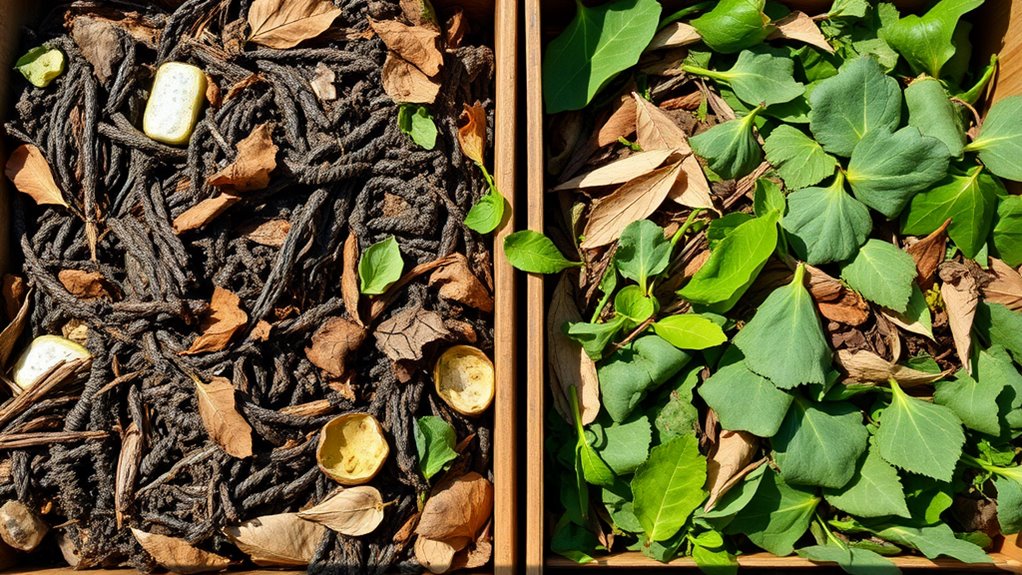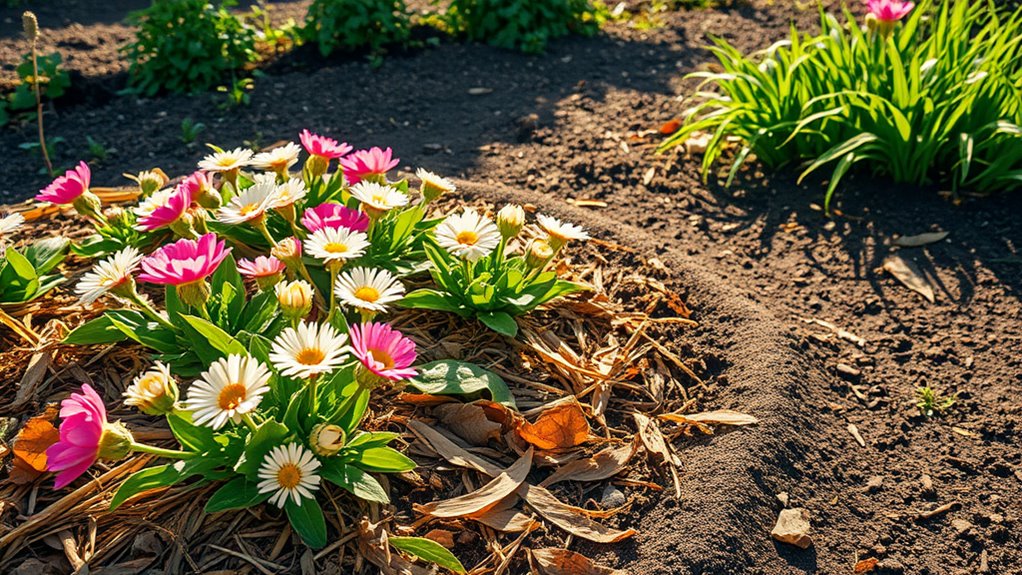The Lazy Gardener’s Guide to Year-Round Color
You’ll achieve year-round garden color with minimal effort by starting in spring: plant low-maintenance bulbs like daffodils and perennials such as coneflowers in well-drained soil, spacing them properly for easy growth. In summer, water deeply in the morning and use thick mulch to retain moisture and suppress weeds. For fall, divide overcrowded plants and add compost to enrich soil. Winter brings subtle charm with decorative mulches and solar lights. These simple strategies keep your space vibrant, so you’ll uncover even more effortless ways to enhance it.
Key Takeaways
- Plant low-maintenance bulbs like daffodils and crocuses in spring for effortless early color.
- Use mulching and efficient watering in summer to sustain vibrant blooms with minimal effort.
- Divide perennials and add compost in fall to prepare for lasting seasonal vibrancy.
- Apply decorative mulches and solar lights in winter for subtle, low-maintenance appeal.
- Select and group resilient plants, like coneflowers and marigolds, for year-round color with little care.
Spring Planting for Effortless Color
As spring awakens your garden, you’ll find that planting a few low-maintenance bulbs and perennials creates effortless color with minimal effort. Before planting, incorporate soil preparation techniques to ensure the soil is well-suited for healthy growth.
For seasonal gardening tips, select bulbs like daffodils and crocuses, which naturalize easily and bloom early. Choose perennials such as coneflowers or black-eyed Susans for reliable returns year after year.
Plant them in well-drained soil during early spring, spacing bulbs 6 inches deep and perennials 12-18 inches apart. This approach ensures vibrant displays with little watering or weeding, setting a foundation for ongoing color without constant attention.
To maximize your garden’s potential, prioritize soil preparation as a key step for healthy plant growth.
Summer Maintenance With Minimal Effort
As you tackle summer maintenance with minimal effort, start by watering wisely to keep your plants hydrated without waste. By incorporating expert watering techniques, you can avoid common pitfalls like inconsistent hydration that may stress your plants.
Weeding sparingly to target only the most invasive intruders, and mulching effectively to lock in moisture.
You’ll check soil moisture first to avoid overwatering, pull weeds just before they overwhelm your flowers, and apply a thick mulch layer to stifle new growth and nourish the soil.
These straightforward tactics ensure your garden stays colorful and healthy while freeing up your weekends.
To further enhance your garden’s health and productivity, consider implementing an innovative watering schedule that maximizes efficiency and saves water.
Water Wisely
During the scorching summer months, you can keep your garden vibrant with minimal effort by watering wisely, focusing on techniques that conserve time and resources.
Water early in the morning or late evening to reduce evaporation, letting plants absorb moisture efficiently. Choose drip irrigation or soaker hoses to target roots directly, saving water and effort.
Apply a thick mulch layer around plants to retain soil moisture and cut down on frequent watering. Always check soil by inserting a finger an inch deep—if it’s dry, water deeply but infrequently to promote strong roots.
This keeps your garden thriving effortlessly.
Weed Sparingly
Now that you’ve nailed watering wisely, turn your attention to weeds by applying a thick mulch layer to smother new growth and make pulling easier.
You’ll spend less time weeding if you target only the persistent ones early in summer, using a simple hand tool to loosen soil around their bases before extraction.
Spot-treat with eco-friendly herbicides on tough spots, but always pull by hand where possible to avoid disturbing roots of desired plants.
Regular, quick checks—say, every two weeks—keep invasions minimal, letting your garden thrive with minimal effort and maximum color.
Mulch Effectively
Effective mulching transforms your summer garden maintenance into a breeze, conserving water and suppressing weeds with just a few simple steps. You’ll start by choosing the right mulch—organic options like bark or straw break down to enrich soil. Apply a 2-4 inch layer around plants, keeping it away from stems to prevent rot. Refresh annually for best results.
| Mulch Type | Application Tip |
|---|---|
| Organic (e.g., straw) | Use for moisture retention and soil improvement. |
| Inorganic (e.g., rocks) | Ideal for weed suppression in high-traffic areas. |
| Compost Mix | Spread thinly for nutrient boost without compaction. |
This approach keeps your garden vibrant with minimal effort, saving you time all summer long.
Fall Preparations for Lasting Vibrancy
As autumn sets in and temperatures drop, you’ll want to focus on simple fall tasks that keep your garden vibrant through the seasons.
Start by planting spring-blooming bulbs like tulips and daffodils in sunny, well-drained spots for effortless future color.
Divide overcrowded perennials, such as hostas, to encourage healthier growth and more flowers next year.
Clear away fallen leaves and dead foliage to prevent diseases and pests.
Top-dress beds with compost to enrich soil nutrients, ensuring plants thrive with minimal ongoing effort.
Additionally, incorporate fall mulching to help protect plants from winter weather and improve soil health.
This practice can also enhance soil health by promoting better moisture retention and pest control.
These practical steps maintain lasting vibrancy without overwhelming your routine.
Winter Strategies for Subtle Appeal
Even though winter’s chill transforms your garden, you can still create subtle appeal with low-maintenance tactics.
Start by clearing away fallen leaves to reveal underlying structures like stone walls or wooden arbors, which provide enduring form.
Layer on decorative mulches, such as pine needles or colored stones, to add texture and hue without weekly care.
Install solar-powered lights along pathways to create a soft glow at dusk, enhancing the winter evening.
Use simple, weather-resistant ornaments that reflect sunlight during the day.
Additionally, place bird feeders in sheltered spots to attract feathered friends, bringing movement to the static scene.
Periodically brush off snow from these elements to maintain their appeal.
Beyond aesthetics, using mulches can help keep your garden consistently moist and thriving even in challenging conditions. This approach aligns with effortless seasonal tips that promote a colorful garden throughout the year.
Choosing Low-Maintenance Perennials
As you transition from winter’s subtle charms to a vibrant growing season, choosing low-maintenance perennials becomes essential for a garden that thrives with minimal effort. You’ll want to focus on hardy varieties that resist pests, require little watering, and bloom reliably. Consider your local climate, soil type, and sunlight when selecting plants like coneflowers or daylilies. These effortless plants are perfect for beginners, providing drought-tolerant options that simplify care routines based on their resilient nature.
| Perennial | Key Features |
|---|---|
| Coneflower | Drought-tolerant, attracts pollinators |
| Daylily | Adapts to poor soil, long bloom time |
| Black-eyed Susan | Self-seeds, low water needs |
| Sedum | Succulent leaves, deer-resistant |
| Hosta | Shade-loving, minimal pruning |
These choices ensure year-round color without constant upkeep, saving you time and hassle. To expand your garden’s appeal, also explore resilient herbs that offer similar low-maintenance benefits and can be easily integrated for added diversity.
Mulching Techniques for Year-Round Ease
Mulching offers an effortless way to protect your garden and extend its color through every season.
You’ll benefit from selecting materials like wood chips or compost, which break down slowly and enrich the soil.
Start by clearing debris and weeds from your beds, then apply a uniform 2-4 inch layer around perennials, keeping it away from stems to prevent rot.
Reapply annually in spring and fall to maintain weed suppression and moisture retention.
This technique stabilizes soil temperature, reduces watering needs, and shields roots from extremes, ensuring low-effort vibrancy all year. Additionally, you can enhance your soil naturally using backyard materials readily available in your yard to further support plant health.
Incorporating effective mulching techniques can transform your garden’s growth and size, as demonstrated by real-world experiences.
Integrating Annuals for Continuous Blooms
To keep your garden blooming continuously, integrate annuals by selecting varieties with staggered flowering periods, such as petunias for spring and marigolds for summer.
You’ll extend the display by planting cosmos or zinnias in fall, ensuring gaps are filled without much effort. Choose low-maintenance types that thrive in your local climate; for instance, deadhead spent blooms to encourage reblooming, but opt for self-seeding options like portulaca to reduce replanting.
Group them with perennials for natural support, minimizing weeding. This approach keeps colors vibrant year-round while you spend less time tending, focusing on enjoyment rather than labor.





